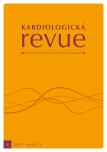News from the 2010 guidelines for the treatment of patients with atrial fibrillation
Authors:
R. Čihák
Published in:
Kardiol Rev Int Med 2010, 12(4): 187-191
Category:
Angiological Symposium
Overview
In summer 2010, the European Society of Cardiology published its new guidelines for the management of patients with atrial fibrillation. The incidence of atrial fibrillation increases, the prevalence is estimated at 1–2%. The treatment includes prevention of atrial remodelling with upstream therapy, prevention of thromboembolic events and heart rate control and rhythm control. Great emphasis is on treatment safety. Detailed risk stratifications of thromboembolic complications have been introduced, the CHA2DS2-VASc score, and risks of bleeding, the HAS-BLED score. Anticoagulation treatment is indicated more often rather than earlier, and recommended are vitamin K antagonists, with, following its approval for use in AF, administration of dabigatran as an alternative. Heart rate control should aim at achieving resting heart rate of less than 110 bpm with more intensive control when symptoms persist or the function deteriorates. To rhythm control, dronedarone, propaphenone, flecainide, sotalol and amiodarone are recommended. The choice of an antiarrhythmic depends on the presence of structural heart disease. Catheter ablation, or alternatively surgery, is indicated when pharmacological treatment had been ineffective.
Keywords:
atrial fibrillation – treatment guidelines – upstream therapy – thromboembolism prevention – rate control – rhythm control
Sources
1. Camm AJ, Kirchhof P, Lipp GY et al. European Heart Rhythm Association; European Association for Cardio--Thoracic Surgery. Guidelines for the management of atrial fibrillation: the Task Force for thr Management of Atrial Fibrillation of the European Society of Cardiology (ESC). Eur Heart J 2010; 31: 2369–2429.
2. Fuster V, Rydén LE, Cannom DS et al. American College of Cardiology; American Heart Association Task Force; European Society of Cardiology Committee for Practice Guidelines; European Heart Rhythm Association; Heart Rhythm Society. ACC/AHA/ESC 2006 guidelines for the management of patients with atrial fibrillation: full text. A report of the American College of Cardiology/American Heart Association Task Force on practice guidelines and the European Society of Cardiology Committee for Practice Guidelines (Writing Committee to Revise the 2001 guidelines for the management of patients with atrial fibrillation) developed in collaboration with the European Heart Rhythm Association and the Heart Rhythm Society. Europace 2006; 8: 651–645.
3. Lip GY, Frison L, Halperin JL et al. Identifying patiens at high risk for stroke despite anticoagulation. A Comparison of Contemporary Stroke Risk Stratification Schemes in an Anticoagulated Atrial Fibrillation Cohort. Stroke 2010, October 21 [Epub ahead of print].
4. Connolly SJ, Ezekowitz MD, Yusuf S et al. RE-LY Steering Committee and Investigators. Dabigatran versus warfarin in patients with atrial fibrillation. N Engl J Med 2009; 361: 1139–1151.
5. Wood S, O´Riordan M. FDA approves dabigatran for stroke prevention, embolism in AF patients. Heartwire 2010; October 20. [http://www.theheart.org/article/1138703.do].
6. Huges S. ROCKET AF: Rivaroxaban meetsprimary end point. Heartwire 2010; November 1. [http://www.theheart.org/article/1142437.do].
7. Ezekowitz MD, Aikens TH, Brown A et al. The evolvivng field of stroke prevention in patients with atrial fibrillation. Stroke 2010; 41: S17–S20.
8. Hohnloser SH, Crijns HJ, van Eickels M et al. ATHENA Investigators. Effect of dronedarone on cardiovascular events in atrial fibrillation. N Engl J Med 2009; 360: 668–678.
9. Van Gelder IC, Groenveld HF, Crijns HJ et al. RACE II Investigators. Lenient versus strict rate control in patients with atrial fibrillation. N Engl J Med 2010; 362: 1363–1373.
Labels
Paediatric cardiology Internal medicine Cardiac surgery CardiologyArticle was published in
Cardiology Review

2010 Issue 4
Most read in this issue
- Aortitis – an inflammation of the aortic wall
- Thrombolytic therapy of acute central retinal artery occlusion
- Rare popliteal artery diseases
- Small aneurysms of abdominal aorta – is it time to change our approach?
